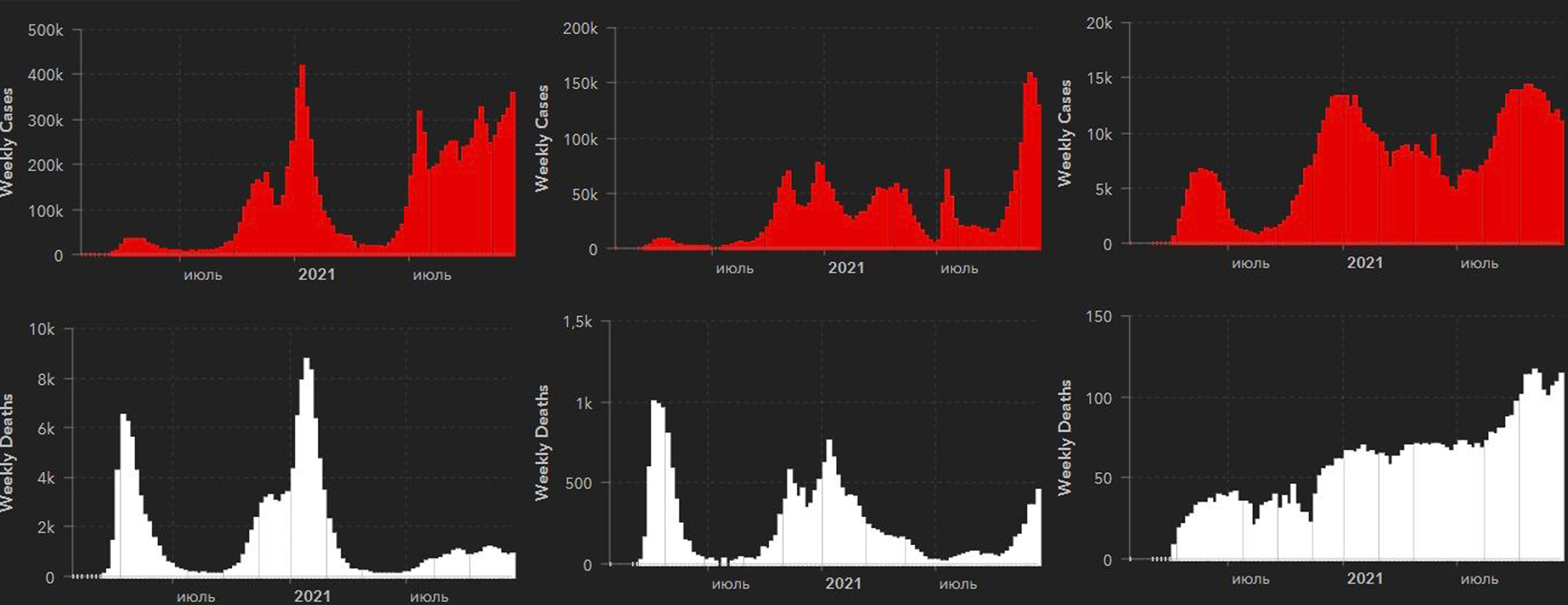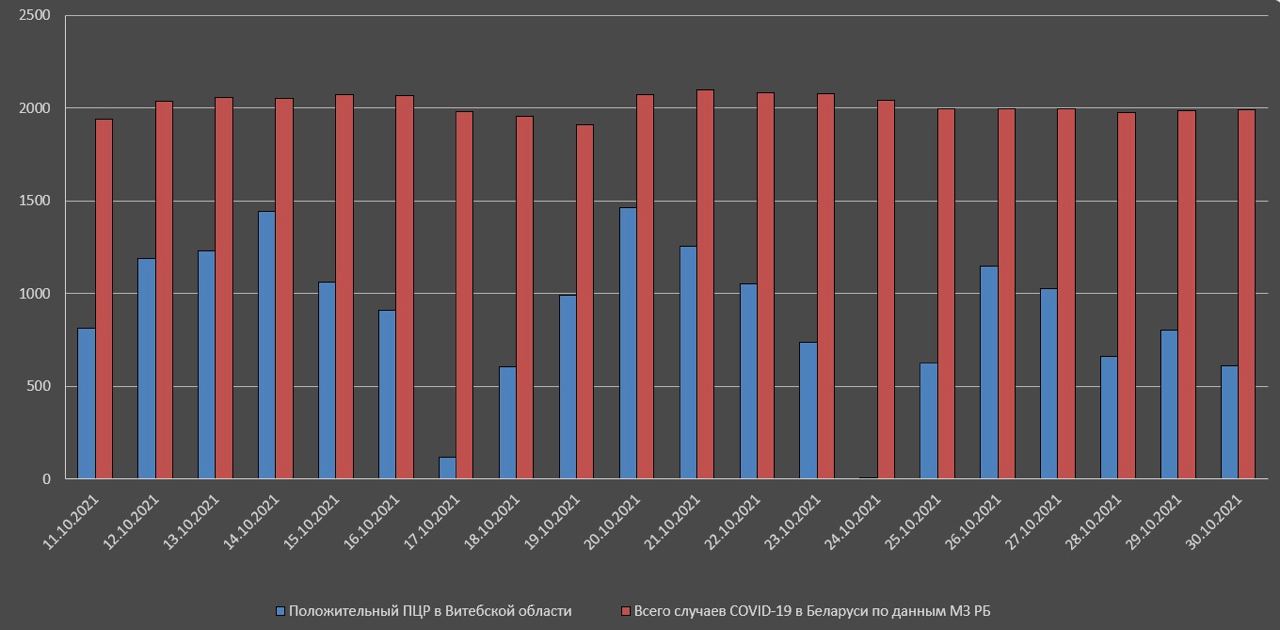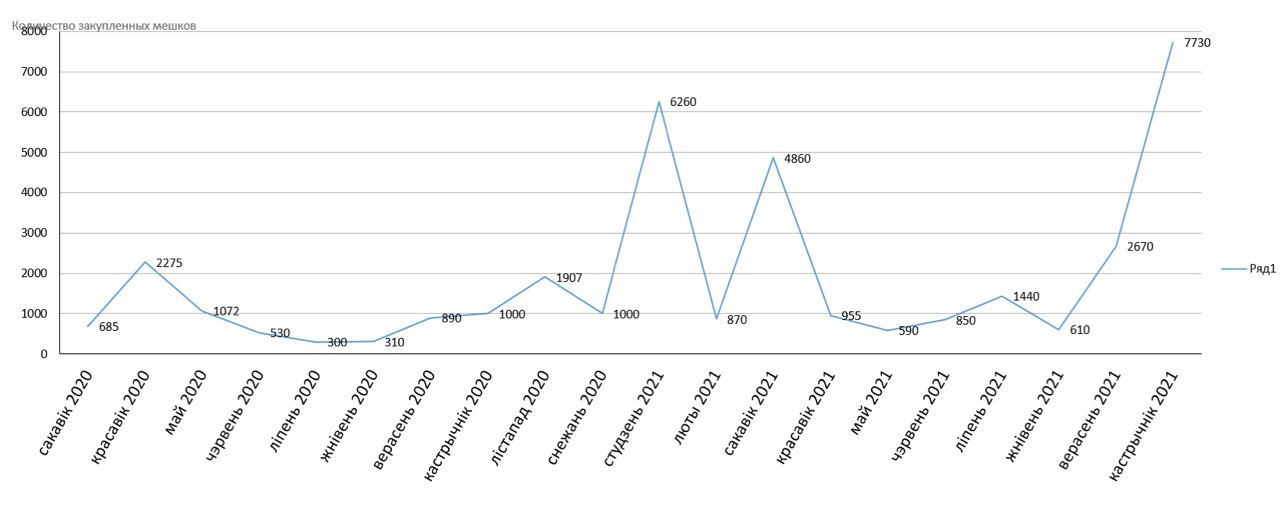The report on the current situation in the healthcare system with regard to COVID-19 in Belarus compiled by the Belarusian Medical Solidarity Foundation.
1. Repurposed in-patient facilities
By early December, many clinics have returned to the customary mode of activities, including Minsk City Oncology Centre and others. Currently, the following hospitals remain at least partly repurposed for treating patients affected by COVID-19: Minsk City Clinical Hospital No. 3 (cardiology department and pulmonology department), Minsk City Clinical Hospital No. 4 (internal medicine department and nephrology department), Minsk City Clinical Hospital No. 5, Minsk City Clinical Hospital No. 6 (internal medicine department and maternity centre), Minsk City Clinical Hospital No. 10 (all but four departments) and some departments of the Minsk City Clinical Hospital for Children’s Infectious Diseases.
2. Case rate and hospital admissions
According to the official data of the Ministry of Health, approximately 1,800 newly diagnosed cases and about 18 deaths are registered per day in the country (as of 10 December 2021). By comparison, in October-November there were around 2,000 cases per day. Such dynamics suggests that the incidence rate has slightly declined.
However, the doctors working in the red zone note that the number of patients admitted with coronavirus infection in October-November was significantly higher than now: hospitals were admitting more than 60-70 COVID-19 patients per day. This indirectly confirms that the figures reported by the Ministry of Health in the autumn were significantly understated and did not correspond to the real situation.
According to data from reliable sources, the current average hospital admission rate is between 20-25 and 40-50 patients with coronavirus infection per day (depending on the clinic). Some of the patients admitted are transferred from other hospitals.
Non-Intensive Care Units (ICUs) in the hospitals listed in part 1 are 85-100% full. Intensive-Care Units are approximately 80-90% full, depending on the hospital.
Doctors report that there are still a large number of patients in critical condition with concomitant pathologies. In addition, a large number of patients develop serious COVID-associated complications, including myocarditis, pericarditis, severe lung fibrosis, panic attacks, etc.
3. Mortality rate
The mortality rate, according to official statistics, is about 18 deaths per day (for December 10-12). That is comparable to mortality at the peak of the wave in October-November.
The lack of dynamics in the number of deaths against the background of reducing morbidity can be explained by two factors. First, severe patients who have spent a lot of time in ICUs are now dying (however, this factor cannot fully explain the current picture, because the pandemic has begun a long time ago, and there have always been many patients in ICUs who have stayed there for months). The second factor is a deliberate downplaying of the number of deaths at the peak of the autumn wave, when doctors reported 10-15 deaths per day in one hospital alone (and such reports were numerous).
If we compare mortality charts of Western countries with honest statistics and charts of Belarus, we can see a striking difference: the charts of Western countries have a “jagged” appearance with ups and downs, that repeat the incidence curves, but with some lag – this reflects a natural undulating epidemic process. The mortality chart of Belarus looks like a “smooth” line with increasing dynamics, which does not reflect the dynamics of incidence change.

Diagram 1. Dynamics of incidence rate (red) and mortality rate (white) in the UK (1), the Netherlands (2) and the Republic of Belarus (3) according to Johns Hopkins University.
According to unofficial data (reports of doctors from the largest COVID-19 clinics), by early December the mortality rate has decreased as compared to the period from early October to the end of November (by two or three times, according to some doctors).
Mortality rate in ICUs is about 60%, which means that 6 out of 10 patients transferred to Anaesthesiology & ICUs do not survive.
Over 5 days (from 4 December to 9 December), 11 patients died in one of the clinics. Meanwhile, according to the official data, 80 patients died across the country over the same period, which still provokes doubts as to the credibility of the official records.
At the end of the text, analytical data from reliable sources are presented, demonstrating the discrepancy between official statistics and the real scale of the COVID-19 pandemic in Belarus.
4. Vaccination
From 7 November through 5 December, the number of fully vaccinated Belarusians increased from 24.4% to 30.5% (which is 12% lower than the global average). It means that approximately 19.500 people or 0.2% of the population get vaccinated per day in the country.
The percentage of COVID-19 vaccination coverage and the vaccination pace are still very low, which is an indication that Belarusians are potentially susceptible to the new coronavirus strains. In the event of a local outbreak of a new COVID-19 strain, the rise in disease cases and death rate may be the same as it was in October and November, and the healthcare system will face the same problems since, until now, they remain unsolved.
The three vaccine types accessible in Belarus are Sputnik V (Gamaleya Research Institute of Epidemiology and Microbiology), Sputnik Light (Gamaleya Research Institute of Epidemiology and Microbiology), and VeroCell (Sinopharm). Sputnik V and VeroCell are used for full primary vaccination, while Sputnik Light is used for revaccination.
The Belarusian authorities keep preventing the vaccines of other manufacturers approved for the European Union from being allowed into the country, despite the fact that a significant number of Belarusians who are still unvaccinated would be willing to get immunized with alternative vaccines, which could result in a faster development of collective immunity. In other words, the lack of trusted vaccines is a creating a major risk for the population.
5. Medical oxygen
Oxygen consumption by hospital units has decreased because fewer patients need oxygen support. To assess the dynamics, we refer to the information from one of the Minsk clinics: oxygen pressure in the units repurposed for COVID patients is currently 4.0 to 4.5 atm. In the period of peak load (October and November), this indicator was 1.7 to 2.0 atm.
6. Equipment, medication
There is still a pending problem of the limited supply of medicines with proven efficacy. For example, low-molecular-weight heparins (LMWHs) were unavailable for a long period, for which reason all hospital patients got non-fractionated heparin (this medication has a poorer safety profile, with a higher rate of post-injection complications, and a lower clinical efficacy, with a stable level of required hypocoagulation vital for COVID-19 patients being impossible to achieve).
LMWHs (Enoxaparin and Fraxiparine) were supplied in December. However, the available quantity of the drugs is not enough to treat all hospital patients affected by coronavirus disease, and LMWHs are prescribed for patients in critical condition only, while others get non-fractionated heparin.
Remdesivir, an antiviral drug, is in good supply and is prescribed for all patients that it is recommended for.
Another medicine, Baricitinib (an inhibitor of Janus kinase) is also available in clinics now and has been in active use for the prevention of systemic inflammatory response. However, it is hard to say whether it is prescribed for all patients where the condition requires such a treatment.
In addition, Levilimab (an inhibitor of Interleukin 6 receptor) has been used in the recent months to relieve the cytokine storm syndrome. According to the global standards, to achieve the intended effect, the drug should be administered for intravenous infusion, which ensures its high concentration in the blood stream and an immediate effect. However, the Levilimab available to Belarusian doctors allows only subcutaneous injections, which, clearly, makes it less efficient for a prompt response to the cytokine storm. Doctors note that the Levilimab used by them has a lower efficacy in the treatment of patients in bad condition as compared to Tocilizumab (an inhibitor of Interleukin 6 receptor) which was widely used before for the same medical reasons. Currently, Tocilizumab is unavailable in the Republic of Belarus.
Molnupiravir, an antiviral drug, is also unavailable, which is unsurprising because its application is still limited around the world.
The lack of availability of reserve antibiotics is a huge problem. The repurposed units, especially intensive care units, have witnessed during the pandemics period the selection of extremely resistant bacterial pathogens which often cause fatal bacterial complications affecting COVID-19 patients. Some reserve antibiotics, like Colistimethate Sodium, Tigecycline and Ceftazidime/Avibactam, are partially effective against such pathogens. Unfortunately, today hospitals experience a critical shortage in these drugs, and most of the clinics do not have them at all. The family members of patients are unable to purchase them from retailers; those who have such an opportunity bring them from Russia (sometimes too late).
7. Reagents
Doctors who treat COVID-19 patients report on irregular supplies of laboratory reagents. Reagents for C-reactive protein, procalcitonin and D-dimers were not in common access for a long term. The level of these substances should be traced every 3 to 5 days for COVID-19 patients, and in the case of patients in critical condition, such tests are required on a daily basis to take medical decisions for diagnosis and treatment purposes.
A reagent for testing IL-6, one of indirect indicators of the cytokine storm process, has been practically impossible to obtain for a long time, even though it is required (together with other clinical data) to decide whether to prescribe Levilimab or Tocilizumab.
According to the doctors from intensive care units, minor disposables for medical care, including breathing circuits, air filters for artificial ventilators, catheters and other items, are often unavailable.
The problem of the shortage of portable ultrasound machines has not been solved to date.
8. Human resources
No reports of mass dismissals have been received from the clinics repurposed for COVID-19 treatment. However, we have information that many doctors and nurses intend to resign after their hospitals get back to their customary activities, because they are highly likely to be deprived of perks payable for dealing with COVID-19 patients.
Besides, health workers keep being dismissed for political reasons. According to the Belarusian Medical Solidarity Foundation, since August 2020, at least 165 dismissals for political reasons have been recorded (for participation in protest acts, active engagement in civic activities, withdrawal from pro-government trade unions, administrative arrests, etc.); health workers remain under pressure (searches, arrests, preventive conversations initiated by law enforcement units). It should be made clear that the dismissal of a health worker in Belarus for political reasons basically means that they are barred from their profession in the country, since the person is unable to get employment (the healthcare system is highly centralized).
- COVID-19 case rate and COVID-19 mortality rate in October 2021 in Vitebsk Region
– Case rate
We have obtained data from Hygiene and Epidemiology Centres of the Vitebsk Region containing results of all PCR tests made in the region from 11 through 30 October 2021.
The diagram below represents the data obtained by us for the Vitebsk Region as compared to the official data of the Ministry of Health for the whole of the Republic of Belarus.

Diagram 2. Number of positive PCR tests in the Vitebsk Region as compared to the number of newly diagnosed COVID-19 cases in Belarus according to the official data of the Belarusian Ministry of Health
Moreover, we have obtained information on all PCR tests made for the period of pandemics in the city of Polotsk, Vitebsk Region. For example, in October 2021, there were 5,397 positive PCR tests for SARS-CoV-2. According to the official data of the Belarusian Ministry of Health for October, 63,958 newly diagnosed COVID-19 cases were recorded in the entire country.
According to the Committee on National Statistics of the Republic of Belarus, the population of Belarus as of 1 January 2021 was 9,349,645, while the population of Polotsk was 80,795. Taking into account that the population of such a large city as Polotsk may be viewed as a representative selection in relation to the total population of the Republic of Belarus, we could extrapolate the data for Polotsk to the country in general and calculate an approximate actual number of newly diagnosed cases of coronavirus infection throughout Belarus for October 2021.
The result of such calculation is 624,500, which is almost 10 times higher than the figure in the official data.
In addition, it should be taken into account that COVID-19 is diagnosed not only on the basis of a positive PCR test, but with reference to other criteria as well, including typical CT findings of lung damage in combination with clinical manifestation.
– Mortality rate
An indirect sign of an extremely high mortality rate connected with coronavirus infection in October and November 2021 is a sharp increase in the number of cadaver pouches (bags for the storage and transportation of human bodies) purchased in that period by the healthcare facilities of the Republic of Belarus. The procurement dynamics shown in the diagram are based on the data provided by the government procurement website.








